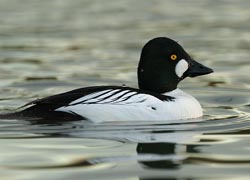County Mayo

Birding County Mayo
County Mayo (Irish: Contae Mhaigh Eo, meaning “County of Plain of Yews”, after Mayo Abbey) is a county in the province of Connacht, located on the west coast of Ireland. The county town of Mayo is Castlebar. It is bounded on the north and west by the Atlantic Ocean; to the south by County Galway; the east by County Roscommon; and the northeast by County Sligo. Mayo is the third-largest of Ireland’s 32 counties in area and 15th largest in terms of population. It is the second-largest of Connacht’s five counties in both size and population. Mayo is located along the west coast of Ireland which is approximately 7,400km in length. There is a distinct geological difference between the west and the east of the county. The west consists largely of poor subsoils and is covered with large areas of extensive Atlantic blanket bog, whereas the east is largely a limestone landscape. Agricultural land is therefore more productive in the east than in the west. The highest point in Mayo (and Connacht) is Mweelrea, at 814 m (2,671 ft)The River Moy in the northeast of the county is renowned for its salmon fishing. Ireland’s largest island, Achill Island, lies off Mayo’s west coast and Mayo has Ireland’s highest cliffs at Croaghaun, Achill Island, while the Benwee Head cliffs in Kilcommon Erris drop almost perpendicularly 900 feet (270 m) into the Atlantic Ocean.
-
Wikipedia
GNU Free Documentation License
http://en.wikipedia.org/wiki/County_Mayo
-
National Parks & Wildlife, Lagduff More, Ballycroy, Westport
-
BirdWatch Ireland - Mayo Branch
WebsiteWelcome to the website. Our aim is to bring together birdwatchers living in or visiting Mayo by providing information in a central location... -
Birdwatch Mayo
Twitter Website@BirdwatchMayo Bird watching group based in County Mayo, on the West coast of Ireland. New members always welcome.
-
NP Ballycroy
WebsiteSatellite ViewBallycroy National Park was established in November 1998, it is Ireland’s sixth National Park and is located on the Western seaboard in northwest Mayo. It comprises of 11,000 hectares of Atlantic blanket bog and mountainous terrain, covering a vast uninhabited and unspoilt wilderness dominated by the Nephin Beg mountain range. Between Nephin Beg and Slieve Carr, at 721 metres above sea level, the highest mountain in the range, lie the Scardaun Loughs… -
NR Annagh Marsh
WebpageSatellite ViewThe Annagh Marsh Reserve is an open pool system set within wet grasslands associated with the rare coastal machair ecosystem (flat sandy grasslands). Historically it was renowned for its breeding Red-necked Phalaropes and was the most southerly breeding location in the world for that species. Unfortunately they ceased to breed in the early 1980’s. However they are making a comeback thanks to the ongoing management of the reserve, initiated by the EU LIFE project between 2002 and 2005. More typical breeding waders to be found are Lapwings and Snipe. Throughout the area Chough, Rock Dove and Twite are regularly seen, sometimes in numbers during the winter and dabbling ducks, Barnacle Geese and Whooper Swans occur in winter, commuting from Termoncarragh Lake. The reserve is also important for an array of rare insects which are found in very few other areas, such as the Great Yellow Bumblebee. -
NR Illaunmaistir
WebpageSatellite ViewThe Illaunmaistir Reserve is a small grass domed island, rising to about 100m, that lies just off the north Mayo coast. During the summer months, looking across to the island from the near mainland, Puffins can be seen as they swirl around above their breeding burrows. Under the cover of darkness, Storm Petrels return to their nests. Along the cliff tops breeding Twite may also be seen. Pods of dolphins or even a Minke Whale can sometimes be spotted offshore. -
NR Termoncarragh Lake
WebpageSatellite ViewThe Termoncarragh Lake Reserve is part of a large, shallow freshwater coastal lagoon set within the rare coastal machair ecosystem (sandy grasslands). The area is rich in wild flowers, insects and birds. Our reserve is part of the lake bed whilst the surrounding lands are privately owned. The whole area forms an extensive Special Protection Area and Special Area of Conservation. It is an important ecosystem which is renowned for its wintering waterfowl, including Whooper Swans and Barnacle Geese. The geese commute between the lake and the Inishkea Islands in winter. Breeding birds include Lapwing, Snipe, Sedge Warbler and Reed Bunting, as well as the secretive Corncrake and Water Rails. -
NR Termoncarragh Meadows
WebpageSatellite ViewThe Termoncarragh Meadows Reserve is an area of species rich semi-improved grasslands associated with an area of coastal pasture which, thanks to our on-going management, is attractive to Corncrakes during the summer months. The meadows and coastal pasture are home to breeding Skylarks, and Wheatears and Ravens breed on the coastal cliffs. During the winter, geese, in particular Barnacle Geese, can be found throughout the area as well as Peregrine, Chough and Rock Dove. The meadows are also important for an array of rare insects such as the Great Yellow Bumblebee, which are found in very few other areas,
